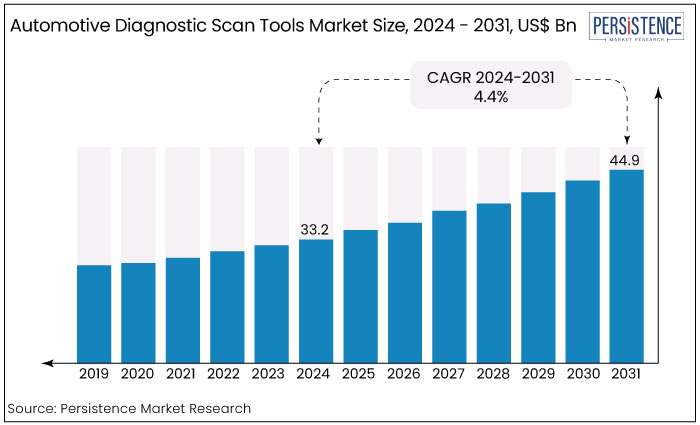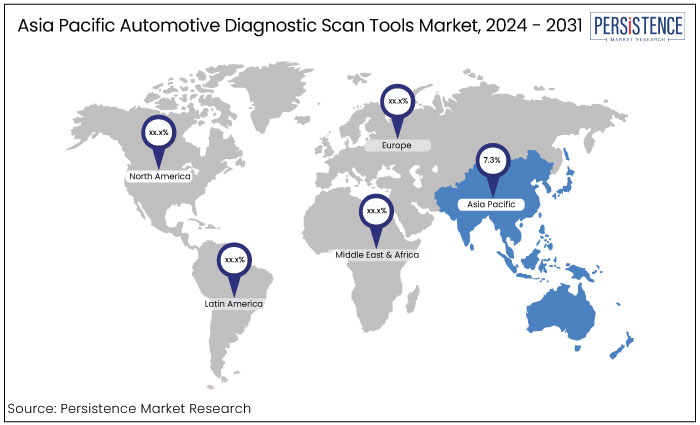Industry: Automotive & Transportation
Published Date: November-2024
Format: PPT*, PDF, EXCEL
Delivery Timelines: Contact Sales
Number of Pages: 170
Report ID: PMRREP34898
The global automotive diagnostic scan tools market is projected to witness a CAGR of 4.4% during the forecast period from 2024 to 2031. It is anticipated to increase from US$ 33.2 Bn recorded in 2024 to a staggering US$ 44.9 Bn by 2031. The market is set to rise through 2031 due to increasing vehicle complexity.
The market is also likely to be driven by a growing shift toward unique diagnostic systems equipped with artificial intelligence and machine learning. These are projected to help enhance fault detection and predictive maintenance capabilities.
The increasing focus on vehicle safety and compliance with regulations are also anticipated to fuel demand for sophisticated diagnostic tools. For instance, the Corporate Average Fuel Economy (CAFE) Standards regulate the average fuel economy of a manufacturer's fleet of passenger cars and light trucks. The goal is to improve fuel efficiency and reduce greenhouse gas emissions. The fleet average is set to reach 49 miles per gallon (mpg) by 2026.

Key Highlights of the Market
|
Market Attributes |
Key Insights |
|
Automotive Diagnostic Scan Tools Market Size (2024E) |
US$ 33.2 Bn |
|
Projected Market Value (2031F) |
US$ 44.9 Bn |
|
Global Market Growth Rate (CAGR 2024 to 2031) |
4.4% |
|
Historical Market Growth Rate (CAGR 2019 to 2023) |
3.9% |
|
Region |
CAGR through 2031 |
|
Asia Pacific |
7.3% |
Asia Pacific is set to lead the automotive diagnostic scan tools industry and rise at a CAGR of 7.3% from 2024 to 2031. The region's growth is primarily driven by rapid innovations in technologies and rising demand for passenger cars.
Government investments aimed at developing diagnostic tools are also expected to create new growth opportunities. A booming automotive industry and enhanced manufacturing capabilities are also contributing to this growth. This combination positions the region as a key player in the automotive diagnostics industry. Apart from government bodies, several private companies are investing in enhancing and advancing these tools. For example,

|
Region |
Market Share in 2024 |
|
Europe |
30.2% |
The automotive diagnostic scan tools market share in Europe is expected to remain at 30.2% In 2024. This is attributed to a booming automotive industry and a keen focus on technological innovations. The demand for cutting-edge diagnostic tools is also being driven by strict regulations associated with vehicle emissions and safety standards.
Several companies in Europe are actively rolling out innovative solutions, positioning the region as a significant hub in terms of market growth.
|
Category |
Market Share in 2024 |
|
Vehicle Type- Passenger Cars |
70% |
Based on vehicle type, the passenger car segment is currently leading the market. The segment benefits from the increasing complexity of automotive systems and the growing number of passenger cars on the road. It is projected to hold about 70% of the total automotive diagnostic tools industry share.
In 2023, the U.S. produced approximately 1.75 million passenger cars. The number is anticipated to rise in various parts of the globe, apart from the U.S. Keeping this sales figure in mind, various companies are developing automotive diagnostic tools mainly for passenger cars. For instance,
|
Category |
Market Share in 2024 |
|
Offering Type - Diagnostic Equipment |
60.1% |
In terms of offering type, the diagnostic equipment segment is currently leading the automotive scanner programmer industry. It holds a key share, primarily due to the mandatory implementation of diagnostic hardware, such as OBD-II ports, in all vehicles across regions like Europe and North America. In 2024, the segment accounted for approximately 60.1% of the total market share.
Increasing complexity of automotive systems and growing need for effective fault identification tools further drive demand for advanced diagnostic equipment. Various companies are set to focus on developing effective OBD-based solutions for vehicles. For instance,
The automotive diagnostic scan tools market is experiencing significant growth driven by technological advancements and increasing vehicle complexity. A prominent trend is the shift toward advanced diagnostic systems that utilize artificial intelligence and machine learning. These also help enhance fault detection and predictive maintenance capabilities.
The rise of electric and hybrid vehicles is further prompting the development of specialized diagnostics tailored to these technologies. The integration of cloud-based solutions allows for real-time data analysis and remote diagnostics, improving efficiency across repair shops and service centers. Additionally, the number of vehicle accidents is increasing. For instance, in the U.S., in 2022, about 42,514 fatal car accidents were reported.
The growing emphasis on vehicle safety and compliance with stringent regulations continues to fuel demand for sophisticated diagnostic tools. These are likely to ensure that automotive professionals can effectively maintain and repair modern vehicles. As a result, the market is poised for continued expansion and innovation.
The automotive diagnostic scan tools market witnessed steady growth at a CAGR of 3.9% from 2019 to 2023. This growth was fueled by the increasing complexity of vehicle systems, rising demand for novel electronic components, and surging need for advanced diagnostic solutions. As vehicles become technologically advanced, the demand for efficient and accurate diagnostic tools rose, thereby pushing the market forward.
The global market is projected to rise with a CAGR of 4.4% from 2024 to 2031. This upward trend is set to be driven by the proliferation of electric and hybrid vehicles. These vehicles require specialized diagnostic tools and the integration of advanced technologies like AI and cloud computing. Several companies are introducing innovative solutions for effective diagnosis of vehicles to compete with their rivals. For instance,
The ongoing emphasis on vehicle safety and compliance with stringent regulations will likely continue to bolster demand for high-quality diagnostic tools. As automotive technology evolves, the diagnostic tools market is poised for significant innovations, offering new opportunities in the coming years.
Car Reprogramming Tool Demand to Rise with High Sales of Passenger Vehicles
The automotive diagnostic scan tools market is set to surge amid rising sales of passenger cars, which are witnessing a significant increase in key countries like China, the United States., and the United Kingdom. High demand for low-emission vehicles and rising government support for vehicle inspections are prompting manufacturers to broaden their offerings of diagnostic tools globally. Government bodies in various countries are hence launching several initiatives in this field. For instance,
Passenger cars represent the fastest-growing segment in the automotive industry. Sales of these cars are increasing rapidly. In 2023, the U.S. auto industry sold around 15.5 million light vehicle units. It includes about 3.12 million passenger cars and just under 12.4 million light trucks. This proves that many people are shifting toward passenger car services. Additionally, rapid urbanization in emerging economies is fueling the need for personal vehicles, further boosting the market.
Mandates Revolving around OBD-II Installation to Fuel Sales
Stringent government regulations in the United States and Europe now mandate all vehicles to be equipped with On-Board Diagnostics II (OBD-II). This system enables GPS fleet tracking devices to gather important data, including fuel consumption, engine revolutions, fault codes, and vehicle speed. Telemetry devices further analyze this information to assess fuel efficiency, trip duration, and instances of speeding, among other metrics.
Fleet operators can then use software interfaces to monitor their vehicles' performance and usage effectively. As a result, the growing adoption of on-board diagnostics in commercial fleets is expected to significantly contribute to the automotive diagnostic scan tools market growth. Government bodies in the U.S. and Europe have further initiated several programs. For example,
High Initial Cost of Advanced Tools to Hamper Market Expansion
The steep initial costs of advanced diagnostic equipment pose challenges for market growth, particularly for small-scale businesses trying to enter the industry. Economic downturns further exacerbate these obstacles, hindering progress. However, these challenges are motivating companies to create more affordable solutions, fostering resilience and adaptability in the market. As businesses respond to economic fluctuations and financial constraints, they are finding innovative ways to navigate these difficulties, ultimately supporting the market's evolution and growth.
Rising Demand for Skilled Technicians and Complex Functioning to Decline Sales
The complex functioning of digital car circuit scanner diagnostic tools requires the expertise of highly skilled technicians. This can be a main barrier to their widespread adoption among consumers.
Several vehicle owners may find it challenging to understand the detailed information provided by these tools or lack the technical knowledge to interpret faulty codes and diagnostic data effectively. This complexity can lead to reliance on professional services, which may deter a few consumers from utilizing these advanced tools. As a result, fostering greater accessibility and training for technicians is essential to encourage consumer confidence and promote high use of diagnostic scan tools in the automotive market. For example,
Companies like Repairify Focus on Remote Diagnostics to Mark Their Presence
Remote diagnostics is a key trend rapidly propelling the professional automotive scan tools industry. With rapid technological advancements, it is now possible to monitor and analyze vehicle systems in real time. It further allows for efficient detection and resolution of issues from a distance. This approach not only speeds up troubleshooting but also helps minimize downtime and lower maintenance costs.
Remote diagnostics are further paving the way for digital solutions that enable effective and timely vehicle diagnostics. This makes it easier for both consumers and technicians to maintain and repair vehicles. For instance,
Increasing Use of Smartphones in Automotive Diagnostics to Create Opportunities
Increasing smartphone use has offered comfort and accessibility to several users. In the U.S., in 2023, about 81.6% of individuals, or approximately 270 million people, likely owned a smartphone. The number of people using mobile devices is anticipated to rise in future.
As automotive diagnostic devices and scanners are mobile compatible, these can be used to perform tests, scan vehicles, and receive reports directly on mobile devices. This convenience means that technicians and vehicle owners can access crucial information on the go, making the diagnostic process more efficient and user-friendly. With everything at their fingertips, users can quickly troubleshoot issues and stay informed about their vehicle’s performance, enhancing the experience of using diagnostic tools.
The automotive diagnostic scan tools industry is highly competitive, with several players striving to innovate and capture high shares. Companies are focusing on developing advanced features like remote diagnostics and mobile compatibility to enhance user experience.
U.S.-based Snap-on Incorporated, for instance, has been launching several innovative products since 2022, including the Solus Edge. It is a powerful diagnostic tool that combines unique vehicle coverage with enhanced data management capabilities. The device allows technicians to perform comprehensive diagnostics quickly and efficiently. It also positions Snap-on as a leader in the market and sets a high standard for technological innovations in automotive diagnostics.
Recent Industry Developments
|
Attributes |
Details |
|
Forecast Period |
2024 to 2031 |
|
Historical Data Available for |
2019 to 2023 |
|
Market Analysis |
US$ Billion for Value |
|
Key Regions Covered |
|
|
Key Market Segments Covered |
|
|
Key Companies Profiled in the Report |
|
|
Report Coverage |
|
|
Customization and Pricing |
Available upon request |
By Offering Type
By Workshop Equipment
By Handheld Scan Tools
By Vehicle Type
By Region
To know more about delivery timeline for this report Contact Sales

The market is set to reach US$ 44.9 Bn by 2031.
It refers to an electronic device that helps evaluate problems in a vehicle by connecting to its computer system.
The BlueDriver Bluetooth Pro is considered the best scan tool, as of 2024.
ACTIA Group, Snap-on Incorporated, and Softing AG are some of the best scan tool manufacturers.
OBD-II generic, OBD-II enhanced, and factory scan tools are the three key types.